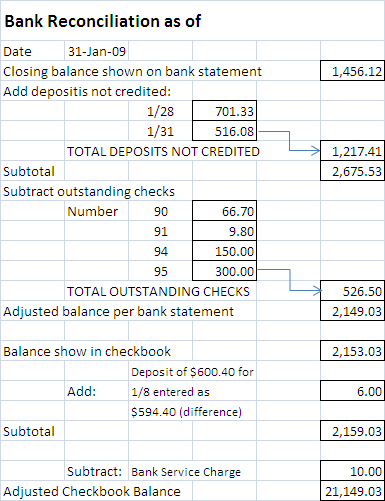7. Bank Reconciliation
Henry reconciles his checkbook with his bank statement and prepares a bank reconciliation for January as follows.
- Henry begins by entering his bank statement balance
- Henry compares the deposits listed on the bank statement with deposits shown in his checkbook. Two deposits shown in his checkbook -- $701.33 and $516.08 -- were not on his bank statement. He enters these two amounts on the bank reconciliation. He adds them to the bank statement balance of $1,458.12 to arrive at a subtotal of $2,675.53.
- After comparing each canceled check with his checkbook, Henry found four outstanding checks totaling $526.50. He subtracts this amount from the subtotal in (2). The result of $2,149.03 is the adjusted bank statement balance.
- Henry enters his checkbook balance on the bank reconciliation.
- Henry discovered that he mistakenly entered a deposit of %600.40 in his checkbook as $594.40. He adds the difference ($6.00) to the checkbook balance. The result is the adjusted checkbook balance of $2,149.03. This equals his adjusted bank statement balance computer in (3).
The only book adjustment Henry needs to make is to the Check Disbursements Journal for the $10 bank service charge. He does not need to adjust the Monthly Summary of Cash Receipts because he correctly entered the January 8 deposit of $600.40.

As we discussed earlier, depreciation. amortization, vehicle expenses, and home offices expenses are handed differently when filing your tax return. Because of this, your fiscal profit is always different from your taxable profits. When compiling your records, it is best to separate your receipts/logs for these items as the information contained on them will be needed when filing your tax return. It is also a good idea to enter depreciable items or start-up costs in separate columns in your Journals.